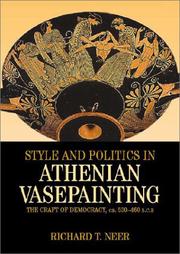| Listing 1 - 7 of 7 |
Sort by
|

ISBN: 0521791111 Year: 2002 Volume: *2 Publisher: Cambridge ; New York Cambridge University Press
Abstract | Keywords | Export | Availability | Bookmark
 Loading...
Loading...Choose an application
- Reference Manager
- EndNote
- RefWorks (Direct export to RefWorks)
Beschilderde vazen [Griekse ] --- Greek vases --- Griekse vazen --- Peinture sur vases grecque --- Politics in art --- Politiek in de kunst --- Politique dans l'art --- Vaasschilderkunst [Griekse ] --- Vase-painting [Greek ] --- Vases [Greek ] --- Vases grecs --- Vases peints grecs --- Vazen [Beschilderde ] [Griekse ] --- Vazen [Griekse ] --- Vase-painting, Greek. --- Vases, Greek. --- Peinture de vases grecque --- Politics in art. --- Vase-painting, Greek --- Vases, Greek --- Greek vase-painting
Book
ISBN: 9780500051665 Year: 2012 Publisher: London : Thames&Hudson,
Abstract | Keywords | Export | Availability | Bookmark
 Loading...
Loading...Choose an application
- Reference Manager
- EndNote
- RefWorks (Direct export to RefWorks)
Book
ISBN: 9780226570631 0226570630 9780226570655 0226570657 1282894757 9781282894754 9786612894756 Year: 2010 Publisher: Chicago University of Chicago Press
Abstract | Keywords | Export | Availability | Bookmark
 Loading...
Loading...Choose an application
- Reference Manager
- EndNote
- RefWorks (Direct export to RefWorks)
In this wide-ranging study, Richard Neer offers a new way to understand the epoch-making sculpture of classical Greece. Working at the intersection of art history, archaeology, literature, and aesthetics, he reveals a people fascinated with the power of sculpture to provoke wonder in beholders. Wonder, not accuracy, realism, naturalism or truth, was the supreme objective of Greek sculptors. Neer traces this way of thinking about art from the poems of Homer to the philosophy of Plato. Then, through meticulous accounts of major sculpture from around the Greek world, he shows how the demand for wonder-inducing statues gave rise to some of the greatest masterpieces of Greek art. Rewriting the history of Greek sculpture in Greek terms and restoring wonder to a sometimes dusty subject, The Emergence of the Classical Style in Greek Sculpture is an indispensable guide for anyone interested in the art of sculpture or the history of the ancient world.
Sculpture, Greek. --- Art, Greek. --- Sculpture grecque --- Art grec --- Art, Greek --- Sculpture, Greek --- Greek sculpture --- Greek art --- Art, Aegean --- Classical antiquities --- Art, Greco-Bactrian --- classics, ancient, history, historical, greece, sculptor, study, academic, scholarly, research, art, artistic, artist, archaeology, literature, literary, aesthetics, visual, accuracy, realism, naturalism, truth, homer, plato, philosophy, philosophical, statues, statuary, textbook, college, university, education, higher ed, politics, myth.
Book
Year: 2019 Publisher: Chicago, Ill.: University of Chicago press,
Abstract | Keywords | Export | Availability | Bookmark
 Loading...
Loading...Choose an application
- Reference Manager
- EndNote
- RefWorks (Direct export to RefWorks)
Book
ISBN: 1421429799 Year: 2019 Publisher: Baltimore : Baltimore, Md. : Johns Hopkins University Press, Project MUSE,
Abstract | Keywords | Export | Availability | Bookmark
 Loading...
Loading...Choose an application
- Reference Manager
- EndNote
- RefWorks (Direct export to RefWorks)
Book
ISBN: 9781421429786 9781421429793 1421429799 1421429780 1421429799 Year: 2019 Publisher: Baltimore
Abstract | Keywords | Export | Availability | Bookmark
 Loading...
Loading...Choose an application
- Reference Manager
- EndNote
- RefWorks (Direct export to RefWorks)
In this volume, Richard Neer and Leslie Kurke develop a new, integrated approach to classical Greece: a "lyric archaeology" that combines literary and art-historical analysis with archaeological and epigraphic materials. At the heart of the book is the great poet Pindar of Thebes, best known for his magnificent odes in honor of victors at the Olympic Games and other competitions. Unlike the quintessentially personal genre of modern lyric, these poems were destined for public performance by choruses of dancing men. Neer and Kurke go further to show that they were also site-specific: as the dancers moved through the space of a city or a sanctuary, their song would refer to local monuments and landmarks. Part of Pindar's brief, they argue, was to weave words and bodies into elaborate tapestries of myth and geography and, in so doing, to re-imagine the very fabric of the city-state. Pindar's poems, in short, were tools for making sense of space. Recent scholarship has tended to isolate poetry, art, and archaeology. But Neer and Kurke show that these distinctions are artificial. Poems, statues, bronzes, tombs, boundary stones, roadways, beacons, and buildings worked together as a "suite" of technologies for organizing landscapes, cityscapes, and territories. Studying these technologies in tandem reveals the procedures and criteria by which the Greeks understood relations of nearness and distance, "here" and "there"âe"and how these ways of inhabiting space were essentially political. Rooted in close readings of individual poems, buildings, and works of art, Pindar, Song, and Space ranges from Athens to Libya, Sicily to Rhodes, to provide a revelatory new understanding of the world the Greeks builtâe"and a new model for studying the ancient world.
Book
ISBN: 9783805346764 Year: 2013 Publisher: Darmstadt Verlag Philipp von Zabern
Abstract | Keywords | Export | Availability | Bookmark
 Loading...
Loading...Choose an application
- Reference Manager
- EndNote
- RefWorks (Direct export to RefWorks)
| Listing 1 - 7 of 7 |
Sort by
|

 Search
Search Feedback
Feedback About UniCat
About UniCat  Help
Help News
News